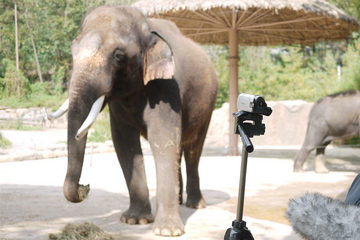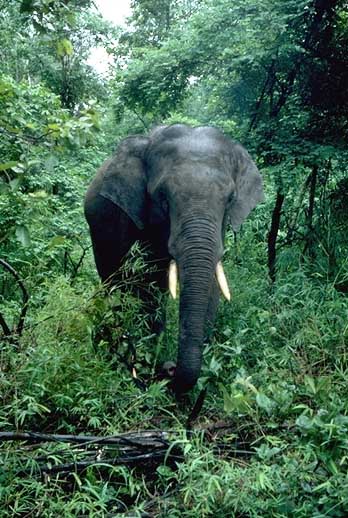1
Snow Leopard
 It is one of the most secretive cats and not many people in the world have had the privilege to see them in the wild in India. The wild cat loves to roam in the rocky mountain ranges of high altitude and it is estimated that in India there are about 200-600 snow leopards found in Hemis National Park, in east Ladakh, Nanda Devi National Park and Valley of Flowers National Park, in the state of Uttarakhand a UNESCO Natural World Heritage Site, and Dibang Wildlife Sanctuary, near Anini.
It is one of the most secretive cats and not many people in the world have had the privilege to see them in the wild in India. The wild cat loves to roam in the rocky mountain ranges of high altitude and it is estimated that in India there are about 200-600 snow leopards found in Hemis National Park, in east Ladakh, Nanda Devi National Park and Valley of Flowers National Park, in the state of Uttarakhand a UNESCO Natural World Heritage Site, and Dibang Wildlife Sanctuary, near Anini.
2
Tiger
 Tigers were once found all over Asia,and from Turkey to Russia but over the last 100 years 93 percent of their range has been lost and half of the world population of tigers now reside in India. According to the last estimate there are 1706 tigers in India and if you wish to come face to face with the regal animal, here are the best places to find them – Madhya Pradesh, in the heart of Central India, has well known Tiger parks of Pench, Kanha and Bandavgarh and have high densities of Tigers. Corbett National Park, in Northern India, in the foothills of the Himalayas, is another beautiful lush park that harbours both tigers and wild elephants, which you have a good chance of seeing, besides a host of other species and some of the best birdlife in India. You want to try and get into the Dhikala range to ensure you get away from most ‘corporate tourism’ that is now booming here. Ranthambhore National Park, the closest park to Delhi in the desert state of Rajasthan, is probably India’s most famous park.
Tigers were once found all over Asia,and from Turkey to Russia but over the last 100 years 93 percent of their range has been lost and half of the world population of tigers now reside in India. According to the last estimate there are 1706 tigers in India and if you wish to come face to face with the regal animal, here are the best places to find them – Madhya Pradesh, in the heart of Central India, has well known Tiger parks of Pench, Kanha and Bandavgarh and have high densities of Tigers. Corbett National Park, in Northern India, in the foothills of the Himalayas, is another beautiful lush park that harbours both tigers and wild elephants, which you have a good chance of seeing, besides a host of other species and some of the best birdlife in India. You want to try and get into the Dhikala range to ensure you get away from most ‘corporate tourism’ that is now booming here. Ranthambhore National Park, the closest park to Delhi in the desert state of Rajasthan, is probably India’s most famous park.
3
Asiatic Lion
 The only place in the world where you can see an AsiaticLion is in the Sasan Gir National Park and sanctuary in Gujarat. The semi deciduous forest makes quite a comfortable home for the Lion and the population is steadily increasing with 400 lions approximately residing here. Far less eloquent than their cousins, the African lions in appearance, the Asiatic lions though are no less aristocratic and just a glance of the king in his jungle abode is enough to make a lasting impression for life.
The only place in the world where you can see an AsiaticLion is in the Sasan Gir National Park and sanctuary in Gujarat. The semi deciduous forest makes quite a comfortable home for the Lion and the population is steadily increasing with 400 lions approximately residing here. Far less eloquent than their cousins, the African lions in appearance, the Asiatic lions though are no less aristocratic and just a glance of the king in his jungle abode is enough to make a lasting impression for life.
4
Ganga River Dolphin
 The Ganges River Dolphin is primarily found in the Ganga and Brahmaputra Rivers and their tributaries in Bangladesh, India and Nepal. The dolphin has been recognized by the Government of India as its National Aquatic Animal. Highest densities of these dolphins have been observed in the Ganges mainstream between Maniharighat and Buxar and within this segment particularly in the Vikramshila Gangetic Dolphin Sanctuary and just downstream between Kahalgaon and Manihari Ghat (near Katihar).
The Ganges River Dolphin is primarily found in the Ganga and Brahmaputra Rivers and their tributaries in Bangladesh, India and Nepal. The dolphin has been recognized by the Government of India as its National Aquatic Animal. Highest densities of these dolphins have been observed in the Ganges mainstream between Maniharighat and Buxar and within this segment particularly in the Vikramshila Gangetic Dolphin Sanctuary and just downstream between Kahalgaon and Manihari Ghat (near Katihar).
5
Lion Tailed Macaque
 Listed as Endangered as the total number of mature individuals is less than 2,500 there are estimates of a continued decline of over 20% of the populations in the next approximately 25 years, due to hunting and continued loss of habitat. This species is endemic to the Western Ghats hill ranges in southwestern India from the Kalakkadu Hills north to Anshi Ghat in the states of Karnataka, Kerala and Tamil Nadu. The forests of Kerala host up to 1,216 adult lion-tailed macaques, according to a large study using estimates from forest sightings. In Tamil Nadu, the Anaimalai Hills support about 500 individuals, though only with two subpopulations. Also found in the Sirsi-Honnavara rainforests of the northern Western Ghats in Karnataka.
Listed as Endangered as the total number of mature individuals is less than 2,500 there are estimates of a continued decline of over 20% of the populations in the next approximately 25 years, due to hunting and continued loss of habitat. This species is endemic to the Western Ghats hill ranges in southwestern India from the Kalakkadu Hills north to Anshi Ghat in the states of Karnataka, Kerala and Tamil Nadu. The forests of Kerala host up to 1,216 adult lion-tailed macaques, according to a large study using estimates from forest sightings. In Tamil Nadu, the Anaimalai Hills support about 500 individuals, though only with two subpopulations. Also found in the Sirsi-Honnavara rainforests of the northern Western Ghats in Karnataka.
6
Indian Rhinoceros
 Although the overall population of this species is increasing, it is still a vulnerable animal highly threatened by poaching for its horns. Also known as the greater one horned rhinoceros the animal is confined to less than ten sites with over 70% of the population in Kaziranga National Park in Assam. Also found in Orang, Pobitara, Jaldapara and Dudhwa.
Although the overall population of this species is increasing, it is still a vulnerable animal highly threatened by poaching for its horns. Also known as the greater one horned rhinoceros the animal is confined to less than ten sites with over 70% of the population in Kaziranga National Park in Assam. Also found in Orang, Pobitara, Jaldapara and Dudhwa.
7
The Nilgiri Tahr
 Known locally as the Nilgiri Ibex or simply Ibex, it is endemic to the Nilgiri Hills and the southern portion of the Western Ghats in the states of Tamil Nadu and Kerala. It is the state animal of Tamil Nadu. These tahrs inhabit the open montane grassland habitat of the South Western Ghats montane rain forests ecoregion. Their range extends over 400 kilometres from north to south, and Eravikulam National Park is home to the largest population. The other significant concentration is in the Nilgiri Hills, with smaller populations in the Anamalai Hills, Periyar National Park, Palni Hills and other pockets in the Western Ghats south of Eravikulam, almost to India’s southern tip.
Known locally as the Nilgiri Ibex or simply Ibex, it is endemic to the Nilgiri Hills and the southern portion of the Western Ghats in the states of Tamil Nadu and Kerala. It is the state animal of Tamil Nadu. These tahrs inhabit the open montane grassland habitat of the South Western Ghats montane rain forests ecoregion. Their range extends over 400 kilometres from north to south, and Eravikulam National Park is home to the largest population. The other significant concentration is in the Nilgiri Hills, with smaller populations in the Anamalai Hills, Periyar National Park, Palni Hills and other pockets in the Western Ghats south of Eravikulam, almost to India’s southern tip.
8
Asian Elephant
 The elephant has been named as the national heritage animal of India. Once widespread in the country, the species is now restricted to four general areas: northeastern India, central India, northwestern India, and southern India. In northeastern India, the elephant range extends from the eastern border of Nepal in northern West Bengal through western Assam along the Himalaya foothills as far as the Mishmi Hills. From here it extends into eastern Arunachal Pradesh, the plains of upper Assam, and the foothills of Nagaland. Further west, it extends to the Garo Hills of Meghalaya through the Khasi Hills, to parts of the lower Brahmaputra plains and Karbi Plateau. Elsewhere in the south in Tripura, Mizoram, Manipur, and the Barak valley districts of Assam, isolated herds occur. In north-western India, the species occurs in six fragmented populations at the foot of the Himalayas in Uttaranchal and Uttar Pradesh, ranging from Katerniaghat Wildlife Sanctuary in Bahraich Forest Division in the east, to the Yamuna River in the west. In southern India, elephants occur in the hilly terrain of the Western Ghats and in parts of the Eastern Ghats in the states of Karnataka, Kerala, Tamil Nadu, and, relatively recently, Andhra Pradesh. There are eight main populations in southern India, each fragmented from the others: northern Karnataka; the crestline of Karnataka–Western Ghats; Bhadra–Malnad; Brahmagiri–Nilgiris–Eastern Ghats; Nilambur–Silent Valley–Coimbatore; Anamalais–Parambikulam; Periyar–Srivilliputhur; and Agasthyamalais.
The elephant has been named as the national heritage animal of India. Once widespread in the country, the species is now restricted to four general areas: northeastern India, central India, northwestern India, and southern India. In northeastern India, the elephant range extends from the eastern border of Nepal in northern West Bengal through western Assam along the Himalaya foothills as far as the Mishmi Hills. From here it extends into eastern Arunachal Pradesh, the plains of upper Assam, and the foothills of Nagaland. Further west, it extends to the Garo Hills of Meghalaya through the Khasi Hills, to parts of the lower Brahmaputra plains and Karbi Plateau. Elsewhere in the south in Tripura, Mizoram, Manipur, and the Barak valley districts of Assam, isolated herds occur. In north-western India, the species occurs in six fragmented populations at the foot of the Himalayas in Uttaranchal and Uttar Pradesh, ranging from Katerniaghat Wildlife Sanctuary in Bahraich Forest Division in the east, to the Yamuna River in the west. In southern India, elephants occur in the hilly terrain of the Western Ghats and in parts of the Eastern Ghats in the states of Karnataka, Kerala, Tamil Nadu, and, relatively recently, Andhra Pradesh. There are eight main populations in southern India, each fragmented from the others: northern Karnataka; the crestline of Karnataka–Western Ghats; Bhadra–Malnad; Brahmagiri–Nilgiris–Eastern Ghats; Nilambur–Silent Valley–Coimbatore; Anamalais–Parambikulam; Periyar–Srivilliputhur; and Agasthyamalais.
Although temple elephants are plenty around India, it is something else to see the regal animal in the wild.
9
Indian Bison (Gaur)
 In India, three major (Western Ghats, Central India and North-East) and two minor (Bihar and West Bengal) Gaur conservation areas have been identified although the Western Ghats and their outflanking hills in south India constitute one of the most extensive extant strongholds of Gaur, with good numbers in Wynaad – Nagarahole – Mudumalai – Bandipur complex.
In India, three major (Western Ghats, Central India and North-East) and two minor (Bihar and West Bengal) Gaur conservation areas have been identified although the Western Ghats and their outflanking hills in south India constitute one of the most extensive extant strongholds of Gaur, with good numbers in Wynaad – Nagarahole – Mudumalai – Bandipur complex.
The largers body structure and the ferocious nature of the Gaur, makes it a must see animal in the wild. Note the contrasting characters from the tamed, domestic cattle.
10
Kashmir Red Stag (Hangul)
 Last but not the least, the Hangul adds a touch of extraordinary beauty to the already enchanting kashmir valley. It is the state animal of Jammu & Kashmir.It’s found in Dachigam National Park at an elevations of 3,035 meters and also in Himachal Pradesh in northern Chamba. Threatened by habitat destruction this red deer’s population has thankfully increased in the past few years to about 300 in the wild.
Last but not the least, the Hangul adds a touch of extraordinary beauty to the already enchanting kashmir valley. It is the state animal of Jammu & Kashmir.It’s found in Dachigam National Park at an elevations of 3,035 meters and also in Himachal Pradesh in northern Chamba. Threatened by habitat destruction this red deer’s population has thankfully increased in the past few years to about 300 in the wild.






is there any other way to save the endangered species rather than putting them in national parks?
Abdul, thank you for your comment. Yes, it would always be better to let nature take care of itself with minimum human interference. But the world that we have made, needs some rules so that at least the animals and plants that are still alive can exist and be propogate safely without man’s greedy arms reaching them. For this, national parks and protected forest areas serve an important role. They give animals the freedom to roam around in a forest and yet, form barriers for humans. In any national park there is a core zone where no one except the forest officials may enter. This is where most of the wildlife of the national park exists. Then there is an outer tourist zone where only tourists enter to watch the animals and then there is the buffer zone where nearby villagers can enter to gather wood etc. So national parks really are serving a great purpose of giving the animals a sense of security which would not be otherwise possible, if left on their own. And animals do live a very wild and natural life in all national parks. So this is the best possible solution for them as well as humans if we need to live with each other.
Yes u are doing awesome thing for animals because it is necessary for us they are a presious part of ecosystem without them we can never thought our tommorow
Hi Atula,
It’s wunderful reading about you taking up a very unchartered path, especially in a country like India. I reside in Delhi and write for children. I’ve just compltede an animal series for age-group 5-8 yrears.Wherein scientific facts about animals are fictionalised to make endearing stories for children.
I am currently trying to crack up a project on tiger because I’ve noticed that there are quite a number of awareness programs like kids for tigers etc, but there is no Indian Series/book/novel by an Indian Writer on Tigers for the Indian Kids.
Its been some weeks that I’ve immersed myself coursing the net, watching videos, reading Born Free by Joy Adamsom etc etc , to absorb the eessence of this royal wild cat.
To work out my series I would need to visit a tiger reserve on a shor string budget. Can you help me with some idea on that.
REgards
Bina
Hi Bina,
So great to know about your work. It would be wonderful to read your stories on animals for children. Do share your work with us when the stories are published. Also the idea of working on tigers is a fine one. Near Delhi, you can visit corbett, though I must warn that Corbett is too large a reserve for you to have definite chances of seeing a tiger. But you can capture the ambience of a forest wonderfully. At Corbett you can stay at any of the forest lodge. There is no electricity in these lodges, but that is perhaps the only disadvantage. Otherwise, it would be an experience of a lifetime to stay in the middle of a jungle and hear animal calls all through the day and night. Wild animal herd also pass by the lodge quite often so that too is a classy experience. Apart from Corbett, you can opt for Ranthambore too where sighting is much more feasible. Both the destinations can be taken as a weekend trip, so quite affordable. Hope this helps. Why not get involved with tigernation.org, the site is streaming live action of tigers in Ranthambore and Bandhavgarh.
great
i am thankful to u about this article. i want to know the actual population of endangered animal – vulture, tiger etc.
Thanks for writing to us. The current population status of tigers in India is 1706 and that of vultures is about 60,000. If you keep visiting Indiasendangered.com we keep updating the current population of many endangered species.
thanks thanks alot. it helped me in making my school project. thanks once again.
Glad that we could be of help Akanksha.
can u tell me the role of indian govt to protect these endangered species
Anirudh, all of these species are protected and have specific protected areas, reserves where human activity is restricted. Other than that individual organisations like Snow Leopard trust, Wildlife SOS, WTI etc. are working towards the protecction and conservation of these species. There are many rehabilitation centres, breeding centres that have been established in India to help breed and conserve an entire species from dying. The Gujarat government and forest department has made a commendable effort in safegurading the future of Asiatic lions. Karnataka and other tiger states are constantly working to save tigers. Much has been done..more needs to be done constantly.
Thanks for the info.
It helped me a lot in school projects
It helped got an A1 .
Thanks Gayatri. Good to know you got an A1 for your project. Keep visitng to know more interesting facts about India’s plants and animals.
It helped me to do my project!! Really great topic 4 a project!!!!! thankyou thanks alot.
hi atula congrats for your efforts to save wildlife rajesh pardeshi(naturalist wildlife photographer) from-Ahmednagar. maharashtra
Thank you Rajesh. Keep visitng.
Thanks ! this information helped me a lot in my school project ……..
Glad we could be of help Shivangi. Do keep visiting to find more interesting facts on endangered animals and plants.
I WANT TO TELL YOU THAT WRITE WHY THIS SPECIES ARE IN DANGERED.BUT YOUR INFORMATION HELP ME TO MAKE MY PROJECT.THANKS ATULA.
good job.. these info. are really usefull.
Glad that it helped you Nimesh. Keep visiting.
Thanks Atula!!!!!! Its really wonderful. Thanks a lot.
You are welcome Tushar. Keep visiting.
Thanks for comment. Can you tell me What NGOs are doing to save extinct & endangered species of animals in India. tell some NGO names too?
Tushar, there are a number of NGOs working to save many endangered animals of India including tiger, lion, elephant and the other not so known species. WWF-India, Wildlife Trust of India, Wildlide SOS, WSPA etc.
what is the role of blue cross in the conservation of these species
Adithya, the Blue Cross society helps domesticated as well as wild animals in various ways, although not necessarily just endangered ones. There are surgical procedures performed on animals by the organisation. They also have animal shelters, rescue shelter for cattles and ambulance services.
the same adithya as above.
i got 10/10 i tmy assignment for which i took help from your website ,thanks.keep updating your website so that many people can get benefit out of it.
regards
adithya
Good to know that Adithya. Well done! Hope you continue to visit and learn new things everyday..:)
it”s wonderful
Thank you. Keep visiting the site to know more about rare and endangered wildlife of India.
Dear Atula
Thanks a lot. it helped me in making my son’s school project. thanks once again. the website gives very useful information and knowledge.
Glad that we could help. Do keep visiting to know more about endangered species of India.
thanks alot atula for this great info. it helped me alot in my science project. i;m very happy!
Glad we could help. Keep visiting to know more about endangered species of India.
I did not get full details about indian endangered species in india.
I want to know more endangered birds and snakes.
thanxxxx……..a alot it helped me in a great way to complete my project…….hope so in future also u will be doing the same………thanxx…….
Glad to help, Harsha. keep visiting.
Hey Atula i want to know about major animal in India, their habits, their population, benifits & harm, plz tell me something thanks
DIVYA
National Geographic website is a good source Divya.
hi atula, thanks for ur info. It was of great info. to me and of great help for my science exhibition. thx a lot .Keep doing.
Glad the article helped you. keep visitng to learn more.
why cheetah has became extinct?
Asian Cheetah is extinct in India but still seen in Iran. They became extinct in India half a century ago. 200 cheetahs were killed here during the colonial period mainly due to conflicts with sheep and goat herders, and not because they were shot by trophy hunters. So habitat destruction, human pressure is the main reason cheetah perished.
hey atula..although I am student of economics, I am deeply interested in wildlife conservation.i am very good at my writing skills and i want to inculcate awareness and respect for all the endangered species among people. i lack exposure but i really want to help in the cause. so can you please tell me a way to do so. is there any website or blog where i can share my work??
Hi Meenakshi, if you are interested, you can send us guest posts for India’s Endangered. Someone from the team will contact you shortly. Thanks.
thanks atula…this year in civil service exam one question was about lion tailed macaque…..i have done right…
Great to know the article helped. Keep visiting.
can you tell me the state where there is no tiger found and one state where there is no elephant found…
Kaushal, There is no natural tiger habitat in J&K, Punjab and Haryana. Also elephants once widespread in India, the species is now restricted to four general areas: northeastern India, central India, northwestern India, and southern India.
thanks author
it helped me to do my project
I was searching but I didn’t get any right and I have open this website it helped me.
now I have got 10 out of 10 (A1) in the project
thanks atula
Glad to know the article helped. Do keep visiting the website to learn more about other species at risk.
what is the only way to save endangered animals?
Adhish, there are many ways to save the endangered animals and the first is to be aware about them, their needs and their equal right of existence in this planet. It is never a single animal that needs saving, but its entire habitat or ecosystem because this is where it gets its food, shelter and site for breeding. If you need a single way it is by saving the habitat.That is a start.
thanks a lot for giving this info. this help me a lot in my school project.
congrats…I hav got a+ in my project after writing this.
Glad the article helped. Keep visiting the site to know more about endangered wildlife of India.
sealion,seahorse,seacow ….kya hota hai………inke baare mein koi baat kyu nahi hoti……..
Kaushal, all three are different species of animals. seals are also known as sea lions. sea horse are horse like animals found in the depth of the sea and sea cow are also known as dugongs.
Best information about the endangeres species.
We should SAVE,LOVE,TREAT the animals.
Thank you indiasendangered.com for your excellent information.
Thank you for your kind comments. Indeed, animals are worthy of all our respect and love.
Thanks it helped me in my project. And got A+. Thanks a lot……..
Glad the article was useful. Keep visiting!
Thanks for providing this valuable information about the endangered species of the India. Its a great works, keep updating the sites.
Regard
Anoop Sharma
Dear sir,
Thanks alot for providing this information. It helped my daughter’s school project.
Pramod Pattnaik
Barbil, Keonjhar(Odisha)
Glad to know the article helped your daughter. Keep visiting!
Hi Atula, Thank you for providing such a
valuable informaton. I am pursuing my career in eco-
tourism so that i can make people aware about the natural
fauna and Flora of our country and your article helped me a
lot.
Thank you.
Glad to know you are pursuing a course on eco-tourism. Hope it helps people love, respect and care for nature even more.
thankyou for this help i will use this for assignment
thanks for your information by the way how many ganges river dolphins are there now?
About 1200-1800 individuals are estimated of the ganges river dolphin
WHAT IS THE REMEDY TO PREVENT ELEPHANT DEATH IN NORTH BENGAL?
MAN ELEPHANT CONFLICT BECOME A VITAL BAD SIGNAL FOR THE ECOLOGICAL CHAIN, AS WELL AS BIODIVERSITY ….
Hi, Thank you for your concern regarding the elephant deaths in Bengal and the man-elephant conflict. You are correct in saying that it’s bad for the ecology and biodiversity of the region. There are plenty of reasons for the conflict – habitat fragmentation, destruction, conversion of forests into farmlands etc. Elephants love to walk for miles each day in search of food and water and therefore their range is huge. When human settlements come in the way, conflict is obvious. On the other hand, development and human needs too cannot be avoided. The West Bengal government recently planned to use birth control technique as a measure. Read about it here. There is also an excellent project running in Tamil Nadu, that resolved the conflict in a unique way. Learn about it here.
Can you tell me the name of birds,plants and animal species that are in danger zone in himanchal Pradesh?
hi mam, I want to do my project on endangered wildlife of Odisha.So, I want some information on endangered species(not plants)that found particularly in Odisha. I need your help.Would You send me the details regarding the topic?
we should save endangered animals in order to make our living possible.i also want to be a part of the movement
we are doing a project on ‘endangered species and their conservation
i also want some information on endangered species in india……kindly help
hi atula, glad to see your work. i need a suggestion from you. its regarding my project.in this we need to do research on various endangered plants and animals in a particular state of india. so i would be very thankful to you if you could suggest me that which would be the best state to search on as there are a lot of states in india and its really tough to choose one single state
Hi Anvi, It is indeed difficult to select one Indian state for the project. But I would suggest one of the North Eastern states like Arunachal Pradesh. The reason is the biodiversity of this state is excellent and there are a number of new species discoveries here. It’s the same reason why many recently discovered species are already on the endangered list. You might also choose one of the states coming withing the western ghats like Karnataka, Kerala or Maharashtra. Hope this helps.
Nice information within limited word ! Thanks atula mam
Glad you liked it. Hope you keep visiting the site.
Hey Ma’am, What’s up? Could you please help me in finding the threatened animal species of State–Himachal Pradesh? Actually, it seems that these higher reaches are not thoroughly scaled and info regarding them on internet is hard to obtain, so if you suggest anything……would be valuable.
We will try our best to provide you with some information soon.
can u do a favour ,? and prepare a list of all national park with details like climate , habitat, famous for species , endangered species in that , is that the park is in IUCN monitor under and how is more important in point of culture and historic cycle to india and our wildlife..
national park and in which species like ( CR,EN,VU list species )both flora and fauna and their importance and habitat of living
so it will be more useful to everyone……..
thanks in advance
Hi Gowtham, thanks for your suggestion. If you visit the ‘eco-travel’ section of the site, you will find that we have already featured few national parks and sanctuaries with a focus on what endangered species are found there. http://indiasendangered.com/category/eco-travel/ We will continue to add to this list, so keep visiting.
hi,
can you tell me the population of ganga river dolphin?
Hi Kshitij, As per IUCN red list, Surveys of portions of the range of the Ganges subspecies have collectively accounted for 1,200–1,800 animals, but the true population is believed to be larger because some potentially important areas have yet to be surveyed (e.g., the Indian Sundarbans). Hope this is helpful to you.
well that was really helpful for
thanks a lot
Thats great you are doing a great job animals
Great job and great achivement
Thank you so much, Atula
It helped my son in his science project
This is a very successful site
I have read the other comments
I hope you will keep on helping us with these knowledgeable problems
Regards,
Mahesh
Hi Atula !!! Thx for the information !!!
Thank u madam for ur information
this site saved my neck from school.
Thanks a lot, but I needed to know more about endangered species of Madhya Pradesh…